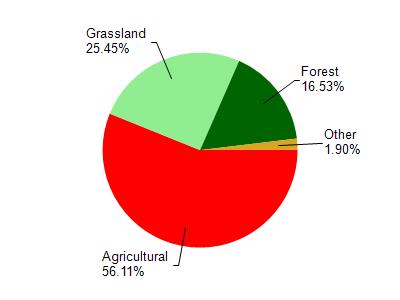Grant
No
No
Yes
Fish and Aquatic Life
Overview
Marlowe Branch, in the Lower Grant River Watershed, is a 6.56 mile river that falls in Grant County. This river is managed for fishing and swimming and is currently considered impaired.
Date 2016
Author Ashley Beranek
Historical Description
From: Smith, Tom D., and Ball, Joseph R., Lake and Stream Classification Project. Surface Water Resources of Grant County, Department of Natural Resources, 1972. Surface Area = 1.19 acres, Length = 4.9 miles, Gradient = 57 ft./mile, Flow = 1.3 c.f.s.
A moderate gradient spring-fed stream beginning at Hurricane and flowing southwest to enter the Grant River three miles southeast of Beetown. Flooding and erosion are major problems during periods of heavy precipitation. Several small soil and water retention structures have been built on small tributaries to help reduce this rapid runoff. No sport fishery exists, but a moderate forage fish population is found in the shallow pools. A large amount of brush has been cut and thrown in the stream near the mouth, partially blocking the flow. Game assets are limited to raccoon, deer, squirrels, and ruffed grouse. A pair of green heron was seen when this survey was conducted. It can be reached from four bridge crossings and ten dwellings are located along the stream.
Date 1972
Author Surface Water Inventory Of Wisconsin
Impaired Waters
Marlowe Branch (959400) was assessed by the regional biologist and based on current and historical Poor mIBIs it was recommended for listing for degraded biological community during the 2016 listing cycle.
Date 2016
Author Aaron Larson
Condition
Wisconsin has over 84,000 miles of streams, 15,000 lakes and milllions of acres of wetlands. Assessing the condition of this vast amount of water is challenging. The state's water monitoring program uses a media-based, cross-program approach to analyze water condition. An updated monitoring strategy (2015-2020) is now available. Compliance with Clean Water Act fishable, swimmable standards are located in the Executive Summary of Water Condition in 2018. See also the 'monitoring and projects' tab.
Reports
Management Goals
Wisconsin's Water Quality Standards provide qualitative and quantitative goals for waters that are protective of Fishable, Swimmable conditions [Learn more]. Waters that do not meet water quality standards are considered impaired and restoration actions are planned and carried out until the water is once again fishable and swimmable
Management goals can include creation or implementation of a Total Maximum Daily Load analysis, a Nine Key Element Plan, or other restoration work, education and outreach and more. If specific recommendations exist for this water, they will be displayed below online.
Monitoring
Monitoring the condition of a river, stream, or lake includes gathering physical, chemical, biological, and habitat data. Comprehensive studies often gather all these parameters in great detail, while lighter assessment events will involve sampling physical, chemical and biological data such as macroinvertebrates. Aquatic macroinvertebrates and fish communities integrate watershed or catchment condition, providing great insight into overall ecosystem health. Chemical and habitat parameters tell researchers more about human induced problems including contaminated runoff, point source dischargers, or habitat issues that foster or limit the potential of aquatic communities to thrive in a given area. Wisconsin's Water Monitoring Strategy was recenty updated.
Grants and Management Projects
| Project Name (Click for Details) | Year Started |
|---|
|
|
Monitoring Projects
| WBIC | Official Waterbody Name | Station ID | Station Name | Earliest Fieldwork Date | Latest Fieldwork Date | View Station | View Data |
|---|
| 959400 | Marlowe Br | 223050 | Marlow Br at Irish Hollow Road | 1/1/2015 | 1/1/2015 | Map | Data |
| 959400 | Marlowe Br | 10016898 | Marlow - Irish Hollow Rd. - Just Downstream. | 5/21/1986 | 1/1/2015 | Map | Data |
|

Watershed Characteristics
Marlowe Br is located in the Lower Grant River watershed which is 129.75 mi². Land use in the watershed is primarily agricultural (56%), grassland (25.40%) and a mix of forest (16.50%) and other uses (1.90%). This watershed has 310.53 stream miles, 33.46 lake acres and 298.95 wetland acres.
Nonpoint Source Characteristics
This watershed is ranked Not Ranked for runoff impacts on streams, Not Available for runoff impacts on lakes and High for runoff impacts on groundwater and therefore has an overall rank of High. This value can be used in ranking the watershed or individual waterbodies for grant funding under state and county programs.However, all waters are affected by diffuse pollutant sources regardless of initial water quality. Applications for specific runoff projects under state or county grant programs may be pursued. For more information, go to surface water program grants.